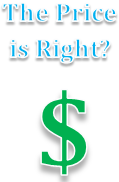Is The Price Right?
Many companies face this question – What should they charge for their products? Right pricing has always been a tussle between the seller and buyer. Traditionally, brands set the price based on competitors offering, market conditions (supply/demand), ROI etc. Then came along value-based pricing wherein a customer would pay a price that would reflect a product’s true value. However, marketers would argue that such a strategy is subjective because value means different things to different consumers. A discount strategy would probably work better instead. In addition, factors like loss aversion play a role – the value of a few cents is much higher when it is deducted rather than added to the bill value.

Case in point
Starbucks charges its customers 10 cents for every paper cup they use. If the customers bring a reusable travel mug, they get a 10-cent discount on any Starbucks beverage. An ideal pricing strategy can be – set one default price and charge 10 cents extra for the paper cup instead of offering a discount for getting a mug.
In January 2011, jcpenney announced its “Fair and Square” pricing strategy. As per the new strategy, the company removed frequent deep-discount sales it had been offering and instead reduced the base price of all items by about 40%. However, the new pricing strategy did not work as in a few months the store traffic declined by 10% and sales by more than 20%. To the customer the ‘fair’ (low) price feels like cheap product whereas a higher priced product offered at a discount appears to be of higher value. Similarly, a few years back Macy’s had reduced the number of coupons it offered to its customers. However, within a year, it restored the coupons, as it realized that consumers preferred them.
In 1992, American Airlines had announced a simplified pricing system (four kinds of fares instead of 16). The pricing strategy was adopted to save $25 million annually by reducing administrative burden with so many fare types. However, in six months American Airlines withdrew the new pricing plan admitting that it was a failure. Competitors were easily undercutting their simple fares.
In April 2012, P&G reported that its sales increased 3% in the quarter. Its competitors, Unilever PLC and Colgate-Palmolive reported sales increase of 8.5% and 6.5% respectively. The problem lay in P&G’s price war strategy to defend market share and not profits. P&G managers reduced prices to hold market share. This resulted in lower margins for the company. In the end, aggressive pricing strategies should be combined with innovation. P&G’s rivals innovated better in many product categories and were more successful.
In September 2011, Bank of America announced that it would charge 5USD per month as debit card fees. Customers were not happy with this decision and by end of the year the number of closed accounts increased by 20% as compared to a year earlier. In July 2011, Netflix increased its prices by 60% for DVD and video streaming rentals. Customers did not like the unjust move and many users cancelled the service.
Points to ponder
- Do not price the product too low thinking that customers want cheaper products. The customer might consider it of low value.
- Do not price the product too high unless it is well differentiated or unique otherwise the competition with similar offering will win.
- Know your customer and what he/she wants. If the majority customer is in the middle-income group and prefer discounts, price accordingly. Similarly, if the majority customer is high-income group, then they might not prefer cheap products considering them to be of inferior value.
- If the customers know the cost, they set the price.
